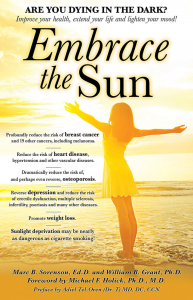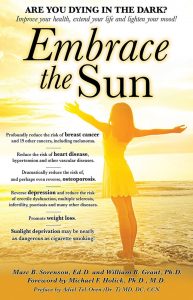Mental illness: Vitamin D deficiency, and thereby sunlight deficiency, plays a major role. By Marc Sorenson, EdD.
Mental illness is a pandemic in the United States. Nearly one in five U.S. adults live with a mental illness (46.6 million in 2017). Mental illness has multiple causes and manifestations. It is especially relevant to understand that sunlight deprivation, leading to vitamin D deficiency, plays a major role in this disorder. It is also important to realize that sun exposure, for typical people, produces about 90% of serum (blood) vitamin D. In addition, this production occurs when midday sunlight touches the skin. However, vitamin D is only one of several photoproducts produced by sun exposure to skin or other body parts. In addition, sun exposure produces serotonin, endorphin, dopamine, and brain-derived neurotropic factor (BDNF). Furthermore, all of these vital chemicals has a profound influence on mental Illness.
An important study on vitamin D
The disease is ubiquitous, as is sun deprivation. Thus, thus an investigation on vitamin D and mental illness reminded me of the affects of sunlight. This laboratory-based study found a high prevalence of vitamin D deficiency among 290 patients with mental illness. Consequently, Only 18% of these patients showed adequate levels of vitamin D. To me, this also means that only 18% were obtaining sufficient sun exposure for good mental health and well-being. The researchers concluded that sensible sun exposure could be a boon to mental health.
Let us now discuss a few of the disorders classified as types of mental illness. Then we will also mention the research that indicates an impressive salutary influence of sun exposure.
ADHD, a mental illness of children
ADHD ( attention deficit hyperactivity disorder) is the most prevalent of all mental disorders in children. Hence, it causes significant problems with executive functions, leading to hyperactivity or impulsiveness not appropriate for the person’s age.
Researchers have found that sun exposure correlates to a decreased risk of ADHD. They assessed the relationship between the prevalence of ADHD and the intensity of the sun in various nations and in US states. And after adjusting for birth weights, infant mortality and other relevant factors, the findings were not altered. It was obvious that sun deprivation by itself was associated with a higher risk of ADHD.
Autism, another disease of youth
Is autism a sun-deficiency disorder? Autism rates are increasing exponentially and associate to vitamin D deficiency, which, of course, associates to sun deficiency. The Autism Society of America defines autism as “a complex developmental disability typically appearing during the first three years of life and is the result of a neurological disorder affecting the normal functioning of the brain, impacting development in the areas of social interaction and communication skills. Both children and adults with autism typically show difficulties in verbal and non-verbal communication, social interactions, and leisure or play activities.”
If vitamin D deficiency and/or sun deprivation relates to autism, symptoms should improve in summer. Thus, a case study reported by Dr. Cannell revealed improvements in autism-related sleep and behavioral problems during summer. Autistic traits such as crying, excitability, hyperactivity and pounding objects profoundly diminished during summer.
Bipolar Disorder
Bipolar disorder (BPD), also known as manic-depressive illness, is a brain disorder causing unusual shifts in mood, energy, activity levels, and the ability to perform day-to-day tasks. Symptoms are severe and can result in damaged relationships, poor job or school performance and even suicide.https://www.nimh.nih.gov/health/topics/bipolar-disorder/index.shtm
Sun exposure resets the body’s circadian rhythms, which are variations in physiology and behavior persistent with a cycle length close to 24 hours. This system is contained in the hypothalamus and stimulated by nerve cells in the retina of the eye in response to light. Research indicates that environmental conditions early in life may imprint the circadian system and influence mental function later in life: Increased number of hours of daylight at the location of birth during the first three months of life are associated with a significantly older age of onset of bipolar disorder. For a longer discussion on bipolar disorder, read the book, Embrace the Sun.
Cognitive disabilities (intellectual disorders)
Another research study, based on a 15-year residential history of varying degrees of sun exposure, produced an interesting result. It showed that cognitive impairment in persons who were below the median exposure to sunlight was 88% greater than in those who were above the median. These same investigators had previously shown that lower levels of sun exposure resulted in a 2.6-times higher incidence of cognitive impairment. Therefore, if you want to think clearly and keep your marbles, regularly soak up some non-burning sunlight.
Depression
Few people realize how prevalent depression is in our society, a mental illness representing a huge drain on the economy. Moreover, according to Steven Genuis, in an editorial in Canadian Family Physician, “The World Health Organization estimates depression costs the American economy about $44 billion annually, equal to the total cost of all cardiovascular diseases.” He also stated that in one decade, there was a 300% increase in the sales of antidepressants, making these medications the top-selling pharmaceuticals in the world. (Genuis, S. Keeping your sunny side up (editorial). Canadian Family Physician 2006:52:42-43.)
So what does the sun do to relieve “the blues?”
The answer probably lies in a chemical responsible for transmitting impulses between nerve cells. This “neurotransmitter,” serotonin, is a natural “upper,” and works in synchronization with the natural “downer,” melatonin. When we awake to sunshine, light enters the eye and stimulates serotonin production. We then quickly become awake and invigorated, and melatonin diminishes. Nevertheless, at day’s end, the bright light disappears (or at least it should), melatonin levels rise, and serotonin levels diminish. We begin to feel sleepy and ideally retire for a good night’s rest. It is a perfect system for our needs—unless we stay up beyond biologically natural hours, by using artificial lighting. Many experts believe that lack of serotonin is a cause of depression.
The most important study on serotonin
Though I mentioned this study in my previous blog on sunlight and depression, it bears repeating here. Dr. Gavin Lambert performed one of the most important and unique studies on serotonin. He and his colleagues measured serotonin levels in response to varying degrees of sunlight. First of all, they drew blood samples from the internal jugular veins of 101 men. In addition, they compared the serotonin concentrations of the blood to weather conditions and seasons. As a result, men measured on a bright day produced eight times more serotonin, than those measured on a dismal day. Of course, the mood improved due to sunlight, with no involvement whatsoever of vitamin D. Thus, regular, non-burning sun exposure is the answer to depression. In addition, remember that sun exposure also leads to the production of other mood enhancers such as nitric oxide, endorphin and dopamine.
Certainly, sunlight deprivation is not the only cause of mental illness, but it is one of the most important.
There are more mental illnesses to discuss, and I will expatiate on those in a future article. In the meantime, protect your mental health by being sure to obtain your share of non-burning sunlight. For more information, visit sunlightinstitute.org, and read the book, Embrace the Sun.
Depression, vitamin D and sunlight. Which is more important? By Marc Sorenson, EdD
Depression is a national horror made worse by fear, worry and lack of sunlight. The Covid-19 pandemic and the tendency to lock people away from sunlight and fresh air has taken an enormous toll.
Depression is more likely to respond to sunlight and vitamin D than sedentary living. That is the message I derived from a recent study. First, the purpose of the research was to estimate cumulative vitamin D doses in 96 depressed patients. These vitamin D doses came from two different sources: solar ultraviolet light, and dietary intake. Another part of the research was to compare vitamin D doses of these depressed patients to 96 age- and sex-matched healthy (non-depressed) controls.
Here are the “Enlightening” results and conclusions.
According to the researchers, there was the major (and probably unexpected) finding. Those with depression had significantly lower vitamin D doses compared to age- and sex-matched healthy controls. Thus, the research again proves the efficacy of sunlight (and possibly vitamin D) for reducing depression. Nevertheless, there was a more important conclusion as stated by the investigators. “While dietary intakes of vitamin D were equal in both groups, patients with depression appeared to have statistically significantly less vitamin D from solar ultraviolet B.” This statement is of transcendent importance due to the establishment of an important fact. That fact is that a superior form of vitamin D results from sun exposure.
Other points to remember regarding sunlight and depression.
In addition to this study, numerous other investigations corroborate the efficacy of sun exposure for ameliorating depression. Serotonin is a potent “upper” that improves mood almost immediately. Sunlight produces Serotonin when it enters the eyes.
The most impressive study on serotonin, sunlight and depression.
Dr. Gavin Lambert did one of the most important studies on serotonin. He and his colleagues measured serotonin levels in response to varying degrees of sunlight. To do so, they drew blood samples from the internal jugular veins of 101 men and compared the serotonin concentrations of the blood to weather conditions and seasons. The remarkable results: Men measured on a bright day produced eight times more serotonin, compared to those measured on a dismal day. Of course, the mood improved due to sunlight, with no involvement whatsoever of vitamin D. Thus, regular, non-burning sun exposure is the answer to depression. In addition, remember that sun exposure also leads to the production of other mood enhancers such as nitric oxide, endorphin and dopamine.
For more information regarding sunlight and depression, visit sunlightinstitute.org and read the book, Embrace the Sun.
Happy sunning!
UV index. Vita min D and health. By Marc Sorenson, EdD
min D and health. By Marc Sorenson, EdD
The UV index is a measure of the intensity of ultraviolet radiation B (UVB) from the sun. It is expressed as a number on a scale of 0-11. A higher number indicates a higher sunlight intensity. Exposure to the ultraviolet B (UVB) portion of sunlight is necessary to cause the skin to produce vitamin D. Nevertheless, unless the body is deeply tanned or naturally very dark, a very high UV index can cause sunburn, so caution is necessary.
A low UV index is also problematic.
However, if the UV index is very low, it cannot stimulate the production of vitamin D in the skin. Vitamin D production is essential for human health. Thus, lack of vitamin D may be a major reason that flu-like diseases occur primarily during winter, when there is little or no vitamin D production. This, of course varies according to latitude.
A List of vitamin D benefits from Business Insider.
A recent article from Business Insider (a Philippines online paper) discussed various health effects of vitamin D and sun exposure. Here are some of their salient points, not all of which are correct.
- The primary cause of vitamin D deficiency is sun deprivation (correct).
- Vitamin D helps keep the immune system, so deficiency could be the reason for frequent flu (correct).
- You can get more vitamin D by spending at least 5 to 10 minutes outside 3 times a week without sunscreen (correct).
How much vitamin D does a person need?
- The most incorrect statement of the article is this. The average adult needs around 600 international units (IU) of vitamin D a day (not correct). For reference, a serving of salmon contains roughly 400 IU (not correct). 20 minutes of full-body, unobstructed sunlight can cause the skin to produce up to 20,000 IU of vitamin D. If 600 IU were the only source of vitamin D, one would produce a level of six ng/ml, which would be woefully inadequate. 600 IU is only slightly better than nothing.
- Fifteen minutes of non-burning midday sun (without sunscreen) would optimize vitamin D levels in a few days. Dark-skinned individuals would need much more exposure, up to an hour.
-
Getting more frequent colds or respiratory infections could be a symptom of vitamin D deficiency (correct). However, it is even more likely to be a sign of sunlight deprivation.
- Colds and flu nearly disappear in the summer when the sun is direct. During this time of the coronavirus epidemic, everyone on earth needs daily direct or indirect sun exposure. Those who do not tan can obtain plenty of sunlight from being outdoors under an umbrella or even in the shade near where the sun is shining.
-
Bone diseases, vitamin D and sunlight.
- Vitamin D deficiency can cause Osteomalacia and Osteoporosis, conditions where your bones become less dense (correct). Sun exposure produces about 90% of the body’s serum levels of vitamin D. In addition, not all vitamin D supplement studies have produced stronger bones.
Sunlight is king for increasing bone strength.
- However, sun exposure, or exposure to sunbeds (tanning beds) produces marvelous results. For example, a Spanish study showed that women in Spain—those who regularly enjoyed sun exposure—had about one-eleventh the risk of hip fractures as women who had little exposure. Women who use sunbeds also have profoundly higher bone mass than women who do not use them. Their vitamin D levels are also remarkably higher.
-
Mental problems due to a low UV index and subsequent vitamin D deficiency.
- Vitamin D has some links to depression (correct). Nevertheless, that link in my opinion is 100% due to to sun deprivation. Dr. Gavin Lambert and his colleagues in Australia measured serotonin levels in response to varying degrees of bright light. To do so, they drew blood samples from the internal jugular veins of 101 men and compared the serotonin concentrations of the blood to weather conditions and seasons. The results were remarkable: Men measured on a very bright day produced eight times more serotonin than those measured on a cloudy, dismal day.
More on the UV index and “solar noon.”
When meteorologists report UV index, the emphasis usually warns against the maximum UV level. That level generally occurs around “solar noon.” Solar noon is a four-hour period stretching from 10:00 AM to 2:00 PM. As you have probably noticed, forecasters constantly warn us to avoid the 10:00 to 2:00 hours. Avoiding intense UV radiation is their watchword. Many of them say, “Get sun exposure in the early morning or late afternoon to produce vitamin D.” They should know that the UV index must be over 3 to produce vitamin D.
These reporters do not understand how low UV index hinders vitamin D production.
They do not comprehend that UV index is so weak in the morning that it produces absolutely no vitamin D. The same is true in the evening. Therefore, the closer to solar noon you plan your outdoor time, the more vitamin D you will produce. Vitamin D produced in the skin from solar UVB exposure does not lead to vitamin D toxicity and is safe, as the body limits its own production.
Another method to measure the efficacy of sunlight for vitamin D is to stand in the sun at any time of day and observe your shadow. If your shadow is shorter than your height, you are producing vitamin D. This, the shorter the shadow, better.
Caveats regarding the UV index and vitamin D. Morning sun is still very healthful.
Early morning sun exposure, when the UV index is very low, (under 3) has remarkable health effects. These include resetting the circadian rhythm, increasing production of serotonin, lowering blood pressure through nitric-oxide production and assisting weight loss. Nevertheless, vitamin D stimulation in the skin is not one of the health effects of early morning light.
So safely soak up the sun at any time of day and reap the health benefits. Never burn.
Happy sunning!
For more information: http://sunlightinstitute.org/ and read the book, Embrace the Su n.
n. 
 Some time ago I wrote a blog on sun exposure and depression, emphasizing the importance of a protein called brain derived neurotropic factor (BDNF). This is an update.
Some time ago I wrote a blog on sun exposure and depression, emphasizing the importance of a protein called brain derived neurotropic factor (BDNF). This is an update.
BDNF is a factor in nerve growth and maturation, and is essential in synapse formation and plasticity. A lack of of it is implicated in psychiatric disorders such as schizophrenia, intellectual disability, autism and depression. Interestingly, it has been shown that unless there is sufficient BDNF in the brain, conventional antidepressants do not work very well,[1] and when BDNF is infused directly into the brains of rodents, it produces an antidepressant effect.[2]
It has also been shown that BDNF has a seasonal variation in concentration correlating with the amount of ambient sun; it increases in the spring and summer and decreases in fall and winter. [3] The authors of this research described the importance of their findings thusly: “This finding is important for our understanding of those factors regulating BDNF expression and may provide novel avenues to understand seasonal dependent changes in behavior and illness such as depression.”
BDNF has been shown to increase significantly after bright light exposure,[4] and in what we would consider to be a remarkably important study, both light exposure and treadmill exercise increased its expression of
in rats,[5] or as the researchers showed, exercise and/or bright light promoted neurogenesis (new nerve cell growth) in the adult rat brain. How important is this finding for adults who are worried about cognitive decline? We are actually seeing an example of new brain cells being built by bright light and exercise. What a wonderful way to help prevent Alzheimer’s disease and maintain mental sharpness into old age! Don’t forget your (safe) sunlight!
[1] Björkholma C, Monteggiab, L. BDNF — a key transducer of antidepressant effects. Neuropharmacology. 2016 March ; 102: 72–79.
[2] Siuciak JA, Lewis DR, Wiegand SJ, Lindsay RM. Antidepressant-like effect of brain-derived neurotrophic factor (BDNF). Pharmacol. Biochem. Behav. 1997; 56(1):131–137.
[3] Molendijk ML, Haffmans JP, Bus BA, Spinhoven P, Penninx BW, Prickaerts J, Oude Voshaar RC, Elzinga BM. Serum BDNF concentrations show strong seasonal variation and correlations with the amount of ambient sun. PLoS One. 2012;7(11):e48046.
[4] Tirassa P1, Iannitelli A, Sornelli F, Cirulli F, Mazza M, Calza A, Alleva E, Branchi I, Aloe L, Bersani G, Pacitti F. Daily serum and salivary BDNF levels correlate with morning-evening personality type in women and are affected by light therapy. Riv Psichiatr. 2012 Nov-Dec;47(6):527-34.
[5] Kwon SJ, Park J, Park SY, Song KS, Jung ST, Jung SB, Park IR, Choi WS, Kwon SO. Low-intensity treadmill exercise and/or bright light promote neurogenesis in adult rat brain. Neural Regen Res. 2013 Apr 5;8(10):922-9.
Sun and cognitive ability by Marc Sorenson, EdD, Sunlight Institute…
If you have depression, you may also have cognitive impairment, according to older research that I just became aware of. The researchers measured cognitive abilities among approximately 14,000 depressed subjects and then exposed them to either one day of sunlight or two weeks of sunlight. They then determined if cognitive disabilities were associated with the sun they obtained.[1]
The results were impressive: Those who were sun-deprived for two weeks had 2.5 times the risk of being cognitively impaired, compared to those who had sufficient sunlight. A one-day exposure made no significant difference in cognition.
Results of other research, based on a 15-year residential history of varying degrees of sun exposure, has also shown that cognitive impairment in persons who were below the median exposure to sun, was 88% greater than those who were above the median.[2] The researchers mentioned vitamin D as a possible mechanism by which sun positively influenced cognition, but they also remarked that regulation of the circadian rhythm by sunlight could be a factor.
Several other studies showed a close, positive association between vitamin D levels and cognition, and as we know, vitamin D levels in most cases are a surrogate measurement for sun exposure.
The message is to get plenty of sunlight to improve mental clarity. Happy thinking!
[1] Shia T Kent, Leslie A McClure, William L Crosson, Donna K Arnett, Virginia G Wadley and Nalini Sathiakumar. Effect of sunlight exposure on cognitive function among depressed and non-depressed participants: a REGARDS cross-sectional study. Environmental Health 2009, 8:34
[2] Kent ST, Kabagambe EK, Wadley VG, Howard VJ, Crosson WL, Al-Hamdan MZ, Judd SE, Peace F, McClure LA. The relationship between long-term sun radiation and cognitive decline in the REGARDS cohort study. Int J Biometeorol. 2014 Apr;58(3):361-70.
Does sun exposure help fight depression? Of course!
By Marc Sorenson, EdD. Sunlight Exposure
Although this blog has discussed sun exposure and its affects on depression, there is some information that I may have neglected to mention. It has been shown that depressed psychiatric patients who resided in sunny rooms stayed in the hospital 2.6 fewer days than those who had “dull” rooms.[1] The sunny rooms had windows, so it is likely that endorphins and serotonin, created by the sun entering the windows, were the natural “uppers” by which the patients felt better. Nitric oxide, produced by UVA light exposure, could also have played a part.
Another of those dull rooms is the one that houses the TV. An interesting study from the University of Pittsburgh found that the more TV teenagers watched, the more likely they were to be depressed as adults.[2] The study author theorized that because there is so much depressing news and programming on TV, the more exposure, the more the internalizing or the depressing programming. For each hour of TV watched, the rate of depression increased significantly.
The researchers may be correct, or it could be that hours of sedentary life in front of the TV, watching commercials for junk food, leads to obesity and poor health as the teenager ages. We have another theory that may supplant, or at least add to those theories. It is possible that years of unnatural indoor habits create deficiency of the aforementioned vitamin D, nitric oxide, endorphins and serotonin, which may have long-term effects. Combined with the deleterious influences of excessive TV watching, that could be a recipe for depression and health disasters. Sun exposure and vitamin D are absolutely necessary for human health and happiness. An indoor lifestyle is unnatural and damaging to the human body and psyche.
Safely embrace the sun and obtain its “feel-good” effects.
[1] Beauchemin KM, Hays P. Sunny hospital rooms expedite recovery from severe and refractory depressions. J Affect Disord. 1996 Sep 9;40(1-2):49-51.
[2]Primack, B. Association between media use in adolescence and depression in young adulthood: a longitudinal study. Arch Gen Psychiatry. 2009 Feb;66(2):181-8
By Marc Sorenson, EdD. Sunlight Institute
Part of our brain function is influenced by a naturally produced protein called Brain-Derived Neurotropic Factor (BDNF), part of a cascade of proteins that promotes neuron growth and prevents neuron death.[1] Research shows that BDNF has an influence on processes and behaviors such as depression and brain plasticity and has a seasonal variation in concentration that correlates with the amount of ambient sun;[2] BDNF increases in the spring and summer and decreases in fall and winter. The authors of this research summed up their findings thusly: “This finding is important for our understanding of those factors that regulate BDNF expression and may provide novel avenues to understand seasonal dependent changes in behavior and illness such as depression.”
Correct levels of BDNF, however, have many other important and positive effects in the body,[3] including promoting of long-term memory, regulation of mood and perception of pain, reduction of Alzheimer’s disease and Huntington’s disease, and control of epilepsy, depression, anxiety, bipolar disorders, schizophrenia and addiction. In addition, it has positive effects on type-two diabetes, cardiovascular disease and colorectal cancer.
BDNF has been shown to increase significantly after bright light exposure,[4] and in what I would consider to be a remarkably important study, both light exposure and treadmill exercise increased the expression of BDNF in rats,[5] or as the researchers showed, exercise and/or bright light promoted neurogenesis (new nerve cell growth) in the adult rat brain. How important is this finding for adults who are worried about cognitive decline? We are actually seeing an example of new brain cells being built by bright light and exercise. But the researchers were not through with their recommendations. They stated this in their summary: “In view of these findings, we propose that moderate exercise or exposure to sun during childhood can be beneficial for neural development.”
Other research has also indicated that physical activity is positively associated with BDNF.[6]
Add one more natural chemical that is inversely associated with depression and directly associated with sun exposure. We now have vitamin D, serotonin, endorphins, dopamine and BDNF.
Want to maintain your IQ and other brain functions? Would you rather not take the chance of suffering from Alzheimer’s? Embrace the sun, and move your body! Be careful not to burn. And remember that the use of sunscreens may negate many of the sun’s wholesome effects.
[1] http://scicurious.scientopia.org/2010/12/13/bdnf-and-depression/
[2] Molendijk ML, Haffmans JP, Bus BA, Spinhoven P, Penninx BW, Prickaerts J, Oude Voshaar RC, Elzinga BM. Serum BDNF concentrations show strong seasonal variation and correlations with the amount of ambient sun. PLoS One. 2012;7(11):e48046.
[3] Juzeniene A. Beneficial effects of UV‐radiation unrelated to Vitamin D. Presentation at International Symposium Biological Effects of Light June 11 ‐ 12, 2015 Homborg, Germany.
[4] Tirassa P, Iannitelli A, Sornelli F, Cirulli F, Mazza M, Calza A, Alleva E, Branchi I, Aloe L, Bersani G, Pacitti F. Daily serum and salivary BDNF levels correlate with morning-evening personality type in women and are affected by light therapy. Riv Psichiatr. 2012 Nov-Dec;47(6):527-34.
[5] Kwon SJ, Park J, Park SY, Song KS, Jung ST, Jung SB, Park IR, Choi WS, Kwon SO. Low-intensity treadmill exercise and/or bright light promote neurogenesis in adult rat brain. Neural Regen Res. 2013 Apr 5;8(10):922-9.
[6] Gomes da Silva S, Arida RM. Physical activity and brain development. Expert Rev Neurother. 2015 Aug 9:1-11.
By Marc Sorenson, EdD, Sunlight Institute…
A recent press release from the Vitamin D Society of Canada discusses the need for vitamin D in the winter, in order to reduce the risk and intensity of seasonal affective disorder, or SAD. SAD is a feeling of low motivation, depressed mood, decreased concentration, anxiety and despair.
Dr. Samantha Kimball, the scientific advisor for the Society, has found that increasing vitamin D intake can help reduce the symptoms of SAD. She mentions that vitamin D, which is generated in the body by sunlight exposure, can modulate the immune system and reduce inflammation, thereby reducing the risk of depression.
Dr. Kimball is correct; the change can be absolutely dramatic based on serum vitamin D levels. One remarkable piece of research showed that those persons who had the lowest levels of D had almost 12 times as likely to be depressed as those who had the highest levels.[1]
Although I fully agree with Dr. Kimball, I can’t help but wish she had mentioned more on the benefits of the sunlight or even sunlamps, which are the most natural ways to increase vitamin D, but are also marvelously effective in improving mood beyond vitamin D.
In addition to vitamin D, there is a chemical produced by the brain in response to sunlight exposure to the eyes. It is called serotonin and is a natural “upper” or mood enhancer. It is also a neurotransmitter and is available to us from bright light entering the eyes. Even is Canada in winter, when there is no vitamin-D stimulating potential in sunlight, just being outdoors when there is sunshine will work to improve or prevent SAD. Sunlight can dramatically increase serotonin levels in the brain.
Dr. Gavin Lambert and his colleagues in Australia measured serotonin levels in response to varying degrees of bright light.[2] To do this, they drew blood samples from the internal jugular veins of 101 men and compared the serotonin concentration of the blood to weather conditions and seasons. The results were remarkable: Men who were measured on a very bright day produced eight times more serotonin than those who were measured on a cloudy, dismal day. They also observed that the effect of bright light was immediate, and that there was no holdover from day to day. Serotonin levels were also seven times higher in summer than winter. There we have another answer to SAD. When the sun is shining, wherever you are, take advantage of it. It will elevate your mood and make you feel more alive. And remember that tanning beds and other types of sunlight do a great job of increasing your vitamin D when the sun doesn’t shine. Finally, bright, full-spectrum lighting will also enhance your mood. Merry Christmas and HAPPY Holidays!
Click this link to read the Vitamin D Society press release: http://www.vitamindsociety.org/press_release.php?id=39
[1] Wilkins CH, Sheline YI, Roe CM, Birge SJ, Morris JC. Vitamin D Deficiency Is Associated With Low Mood and Worse Cognitive Performance in Older Adults. Am J Geriatr Psychiatry 2006;14:1032–1040).
[2] Lambert GW, Reid C, Kaye DM, Jennings GL, Esler MD. Effect of sunlight and season on serotonin turnover in the brain. Lancet. 2002 Dec 7;360(9348):1840-2.
We have discussed the extraordinary ability of sunlight exposure or other bright-light exposure to profoundly increase the production of serotonin, a brain chemical that is a potent mood enhancer. The most remarkable research on this subject was by Dr. Gavin Lambert and his colleagues in Australia. They measured serotonin levels in response to varying degrees of bright light.[1] To do this, they actually took blood samples from internal jugular veins of 101 men and compared the serotonin concentration of the blood to weather conditions and seasons. The results were remarkable: MEN WHO WERE MEASURED ON A VERY BRIGHT DAY PRODUCED EIGHT TIMES MORE SEROTONIN THAN THOSE WHO WERE MEASURED ON A CLOUDY, DISMAL DAY. They also observed that the effect of bright light was immediate, and that there was no holdover from day to day. SEROTONIN LEVELS WERE ALSO SEVEN TIMES HIGHER IN SUMMER THAN WINTER. NO WONDER WE FEEL SO GOOD WHEN WE ARE OUTSIDE IN THE SUMMERTIME!
The most popular anti-depressant drugs also work by keeping serotonin levels higher, but there are frightening side-effects. The Food and Drug Administration (FDA), indicates that antidepressant medications known as selective serotonin re-uptake inhibitors (SSRI’s) may increase depression in some cases and lead to suicidal thoughts. Some of the brands involved are Paxil, Lexapro, Prozac, Effexor, Zoloft, Wellbutrin, Luvox, Celexa and Serzone, although the FDA listed 34 drugs. The entire list is at fda.gov/cder/drug/antidepressants/. They state the following: “The Food and Drug Administration asks manufacturers of all antidepressant drugs to include in their labeling a boxed warning and expanded warning statements that alert health care providers to an increased risk of suicidality in children and adolescents being treated with these agents, and additional information about the results of pediatric studies.”
The FDA lists several additional warnings and instructions about these drugs:
-
Antidepressants increase the risk of suicidal thinking and behavior (suicidality) in children and adolescents with MDD (major depressive disorder) and other psychiatric disorders.
-
Anyone considering the use of an antidepressant in a child or adolescent for any clinical use must balance the risk of increased suicidality with the clinical need.
-
Patients who are started on therapy should be observed closely for clinical worsening, suicidality, or unusual changes in behavior.
-
Families should be advised to closely observe the patient and to communicate with the prescriber.
Missing are two important facts: (1) SSRI’s increase bone loss.[2] Women who used SSRI’s lose nearly 80% more bone per year than non-users! And as expected, later research shows that SSRI use correlated to a 75% greater likelihood of sustaining a fracture.[3] Secondly, SSRI’s don’t work very well. A meta-analysis of data on SSRI’s submitted to the FDA indicates that placebos (sugar pills) are as effective as SSRI’s in reducing depression; [4] in other words, only drug companies benefit from SSRI’s—not depression sufferers.
Based on that information, it seems prudent to increase our endorphins (and our happiness) through sunlight exposure. It is what nature intended.
[1] Lambert GW, Reid C, Kaye DM, Jennings GL, Esler MD. Effect of sunlight and season on serotonin turnover in the brain. Lancet. 2002 Dec 7;360(9348):1840-2.
[2] Diem SJ, Blackwell TL, Stone KL, Yaffe K, Haney EM, Bliziotes MM, Ensrud KE.. Use of antidepressants and rates of hip bone loss in older women; the study of osteoporotic fractures. Arch Intern Med 2007:167:1231-32.
[3] Sheu YH, Lanteigne A, Stürmer T, Pate V, Azrael D, Miller M5. SSRI use and risk of fractures among perimenopausal women without mental disorders. Inj Prev. 2015 Jun 25. pii: injuryprev-2014-041483. doi: 10.1136/injuryprev-2014-041483. [Epub ahead of print]
[4] Kirsch, I. et al. Initial severity and antidepressant benefits: a meta-analysis of data submitted to the Food and Drug Administration. PLoS Medicine 2008;5:e45. doi:10.1371/journal.pmed.0050045
By Marc Sorenson, EdD, Sunlight Institute
Go ahead and soak up some sun! So says Dr. Holick.
It is great to have Dr. Michael Holick appearing in news articles occasionally, because he helps to stop the pervasive lies that frighten the public from partaking of life-saving sun exposure. A recent article appearing in the Washington Post, and written by Dr. Holick, makes some good points that all of us should have at our fingertips when being confronted by the anti-sun militants:
- The American Academy of Dermatology recommends never exposing bare skin to the sun, or even on a cloudy day, without sunscreen. [How about that for insanity!]
- The FDA calls ultraviolet radiation a carcinogen. [ridiculous]
- These messages cause widespread paranoia
- SPF 30 sunscreens reduce vitamin D production by 97%.
- A lack of vitamin D is associated with increased risk for Type 1 and 2 diabetes, multiple sclerosis, rheumatoid arthritis, Crohn’s disease, cardiovascular disease, stroke, depression, Alzheimer’s disease, schizophrenia, colon and breast cancer, influenza and tuberculosis.
Much of the rest of the article concentrates on putting the lie to the nonsense about hiding ourselves from the sun, as he talks about how vital vitamin D is for cancer, diabetes and other diseases. He then discusses the best way to get sunlight exposure. This is a must read!
This is the link to the article: https://www.washingtonpost.com/opinions/go-ahead-soak-up-some-sun/2015/07/24/00ea8a84-3189-11e5-97ae-30a30cca95d7_story.html.








